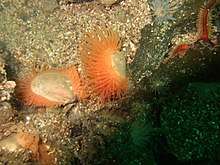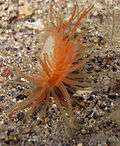Limaria hians
Limaria hians, the flame shell, is a species of small saltwater clam, a marine bivalve mollusc in the family Limidae. This species is native to the northeastern Atlantic Ocean.
| Limaria hians | |
|---|---|
 | |
| Two flame shells which have been torn from their protective nest at the bottom of Loch Carron in Scotland | |
| Scientific classification | |
| Kingdom: | Animalia |
| Phylum: | Mollusca |
| Class: | Bivalvia |
| Order: | Limida |
| Family: | Limidae |
| Genus: | Limaria |
| Species: | L. hians |
| Binomial name | |
| Limaria hians (Gmelin, 1791) | |
Biology

The flame shell resembles a scallop with a bright orange fringe of tentacle-like filaments emerging from between the valve of its shell.
These bivalves create nests through the use of byssal threads to bind small stones, shells and other detritus together, enclosing themselves as form of protection. Individual nests expand over time, eventually overlapping with other nests and consequently forming expansive reefs. Holes in the reef allow fresh seawater to flow through, preventing stagnation. These reefs support a diverse marine ecosystem with one study showing six nest complexes supporting 19 species of algae and 265 species of invertebrates.[1]
Distribution
This species is found in the northeast Atlantic, ranging from Lofoten to the Canary Islands, including the Mediterranean Sea. In the British Isles, the distribution of this species is primarily in the west coast of Scotland from the sublittoral (below low tide), down to 100m, although there are patchy records of the species being found in more southerly regions of the United Kingdom. There are a number of well-known colonies on the sea bed in Loch Carron, below Strome Castle. In 2012 a bed of 100 million flame shells covering an area of 75 hectares was found during a survey of Loch Alsh undertaken by Heriot-Watt University on behalf of Marine Scotland. Richard Lochhead, Cabinet Secretary for Rural Affairs and the Environment said: "The flame shell must be considered among the most remarkable species in our waters, with a dazzling array of orange tentacles. Many would place such an exotic species in far-flung tropical reefs - not realising they dwell under the waves just off the coast of Skye. This important discovery may be the largest grouping of flame shells anywhere in the world." [2]
References
- "Flame shell beds". www.snh.gov.uk. Scottish National Heritage. Retrieved 29 November 2014.
- "Marine Scotland survey uncovers 'huge' flame shell bed". BBC News Online. 2012-12-26. Retrieved 2012-12-27.
References
- Hall-Spencer JM & Moore PG (2000) Limaria hians (Mollusca: Limacea): a neglected reef-forming keystone species. Aquatic Conservation 10, 267-277.
- Dr Harvey Tyler-Walters 2008. Limaria hians. Gaping file shell. Marine Life Information Network: Biology and Sensitivity Key Information Sub-programme [on-line]. Plymouth: Marine Biological Association of the United Kingdom. [cited 29/11/2014]. Available from: <http://www.marlin.ac.uk/speciesinformation.php?speciesID=3679>
- British Beasts - Flame Shell & Horse Mussel
- Marine Life Information Network - Limaria hians
- WoRMS info for this species